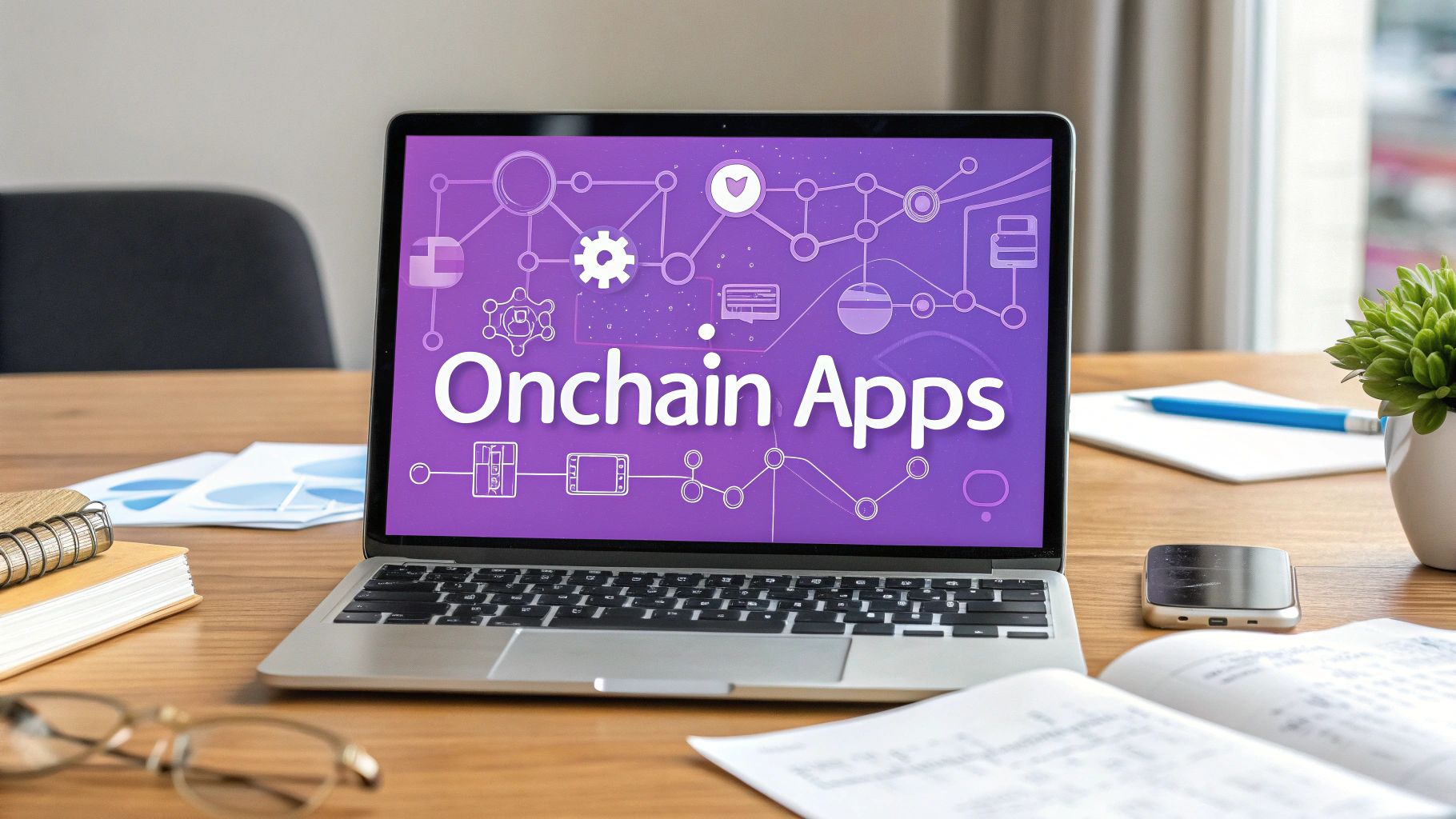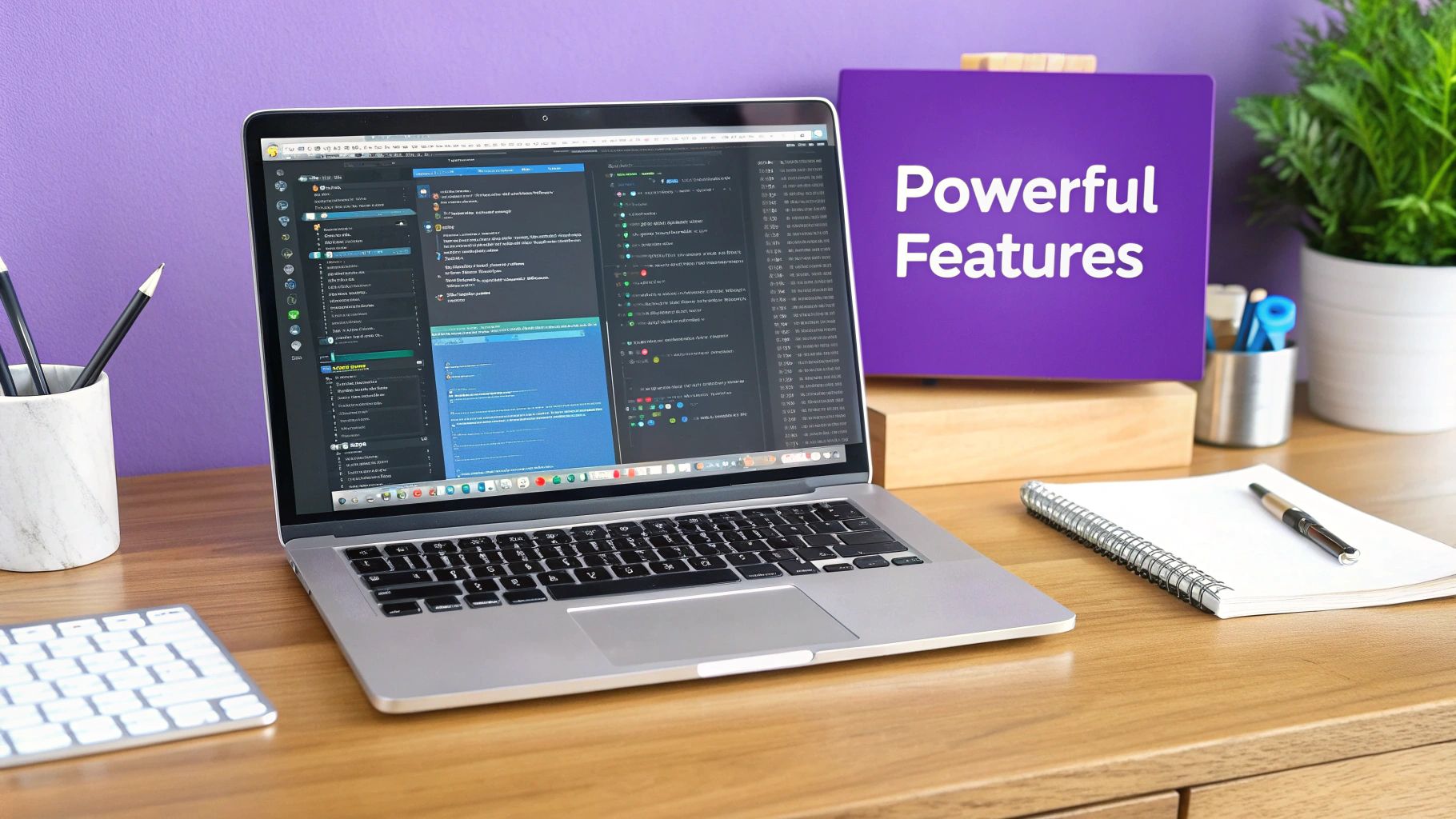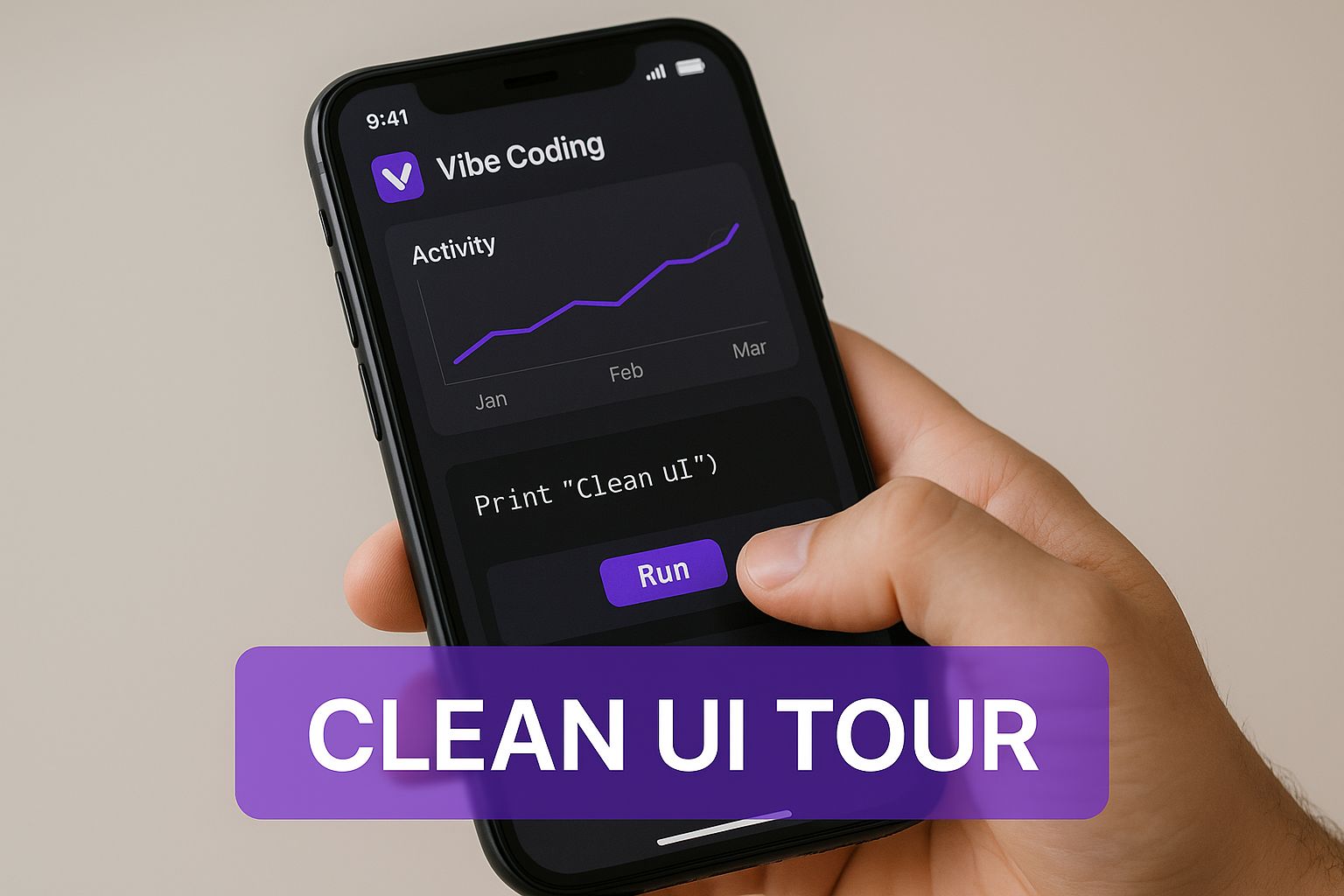Build Onchain Apps With a Vibe Coding App

Ever heard of a vibe coding app? It's exactly what it sounds like. You give it an idea—a high-level concept, a vibe—and it turns that into functional software. For complex spaces like blockchain, this is a game-changer. It lets you build sophisticated applications using plain English instead of wrestling with code, flipping the script on how we make digital products.
The New Way to Build Onchain Apps
Building onchain applications used to be a walled garden, accessible only to developers who lived and breathed languages like Solidity and understood the tangled web of blockchain architecture. This steep learning curve meant a lot of great ideas from non-technical founders never saw the light of day. Vibe coding completely shatters that barrier, inviting a much wider pool of innovators to the party.
Think about it: you describe your dream decentralized app (dApp) in a simple sentence, and an AI brings it to life. That's the core idea here. Vibe coding apps are the next big leap for Low-Code/No-Code platforms, making onchain development accessible to everyone. These tools are built to understand the intent—the vibe—behind what you're asking for.
From Concept to Code, Instantly
A top-tier vibe coding studio like Dreamspace basically acts as your AI development partner. Instead of grinding out hundreds of lines of code for a single smart contract, you just describe what you want it to do.
For instance, you could just type: "create an NFT collection with a limited supply of 1,000 tokens and a minting fee of 0.05 ETH." That's your starting point.
This method has some clear wins:
- Go Fast: You can get from a raw idea to a working prototype in a tiny fraction of the time it would normally take.
- No Experience Needed: You don't have to be a blockchain wizard to build something powerful and useful.
- Focus on What Matters: Spend your energy on the creative vision and strategy for your project, not on the tedious technical details. The AI handles that.
How This Changes the Game
This isn't some niche trend on the fringes; it's a full-blown movement. Vibe coding platforms are making serious waves in software development, with about 87% of Fortune 500 companies already using at least one.
The numbers don't lie. The global market has ballooned to $4.7 billion. Companies are reporting a 37% boost in developer productivity and are getting their products out the door 29% faster. You can dig into more of these vibe coding platform statistics for 2025 if you're curious.
This all proves that turning a vibe into code isn't just a cool concept—it's a real, practical, and powerful way to build. As we walk through this guide, you’ll see firsthand how an AI app generator like Dreamspace makes this entire process feel effortless.
Kicking Off Your First Dreamspace Project

Alright, before we start turning your brilliant idea into a live, onchain reality, we need to lay some groundwork. This first step is all about taking that vision swirling in your head and giving the AI a clear, understandable starting point. Trust me, getting this right from the jump makes the whole process with any vibe coding app a whole lot smoother.
First things first, you'll need to create your Dreamspace account and spin up a new project. As a leading vibe coding studio, the platform is pretty slick and intuitive. You’ll land on a clean dashboard that keeps everything you need close by. Don't just click through—take a minute to poke around and get a feel for the layout.
This isn't just about checking boxes, though. You're setting the stage for the AI to become a true collaborator. The goal here is to establish your project's 'vibe'.
Nailing Down Your Project’s Vibe
So, what exactly is a "vibe"? Think of it as the soul of your app. It's the core concept that tells the AI what to build. It’s like giving your AI dev team the ultimate creative brief. A clear, well-defined vibe means the code and assets it generates will actually match what you want, right from the first prompt.
To really craft an effective vibe, you need to get specific about a few things:
- Project Scope: What's the main thing your app does? Try to be focused. Instead of something vague like "a decentralized social network," drill down to "a token-gated community forum for holders of XYZ NFT." See the difference?
- Core Features: Make a list of the absolute must-haves. For our forum example, that might be wallet connections for login, the ability to create new posts, and simple comment threads.
- Target Blockchain: You need to pick your chain—Ethereum, Polygon, Solana, you name it. This decision ripples through everything from the smart contract language to potential gas fees for your users.
Putting in this thought upfront is the difference between a productive coding session and a really frustrating one. The more detailed your vibe is, the less you'll have to correct the AI later.
Pro Tip: Your very first prompt to the AI app generator should be a concise summary of this vibe—your elevator pitch. For example: "Generate a project for a token-gated web app on Polygon. It needs a smart contract to check ownership of 'MyNFT' and a simple frontend with a login page and a members-only message board."
This kind of direct, specific instruction gives the Dreamspace AI app generator a clear roadmap. From there, the AI can get to work building out the necessary pieces—smart contracts, frontend scaffolding, and blockchain queries—that actually align with your vision. You're basically starting a conversation with the AI, and you're the one leading it.
Generating Your First Smart Contract With a Vibe
Alright, let's get to the fun part—turning your project's vibe into a real, onchain asset. This is where Dreamspace, as a vibe coding studio, really comes alive. You're about to spin up a custom smart contract using just descriptive prompts, no Solidity required.
Think of it like having a conversation. You give the initial creative brief, and the AI builds the complex scaffolding. Let's say you want to launch an exclusive NFT collection. A lazy prompt like "make an NFT contract" just won't cut it. It’s too broad and leaves way too much to chance.
A much better, vibe-driven prompt would be something like: "Generate an ERC-721 smart contract for an NFT collection called 'Cyber Punks 2088' with a total supply of 5,000 tokens. The minting fee should be 0.02 ETH per token." That level of detail gives the vibe coding app solid guardrails, producing code that’s much closer to your actual vision right out of the gate.
The art of crafting a good prompt is crucial. To show you what I mean, let's compare some vague prompts with more effective ones.
Refining and Iterating on Your Contract
The first draft you get from the AI is just the starting point. The real magic happens in the back-and-forth, treating the AI like a junior developer you're mentoring. This collaborative flow is what makes building with the Dreamspace AI app generator so powerful.
Let’s say the AI just generated that initial contract for you. Now, you can start giving feedback in plain English to tweak it.
- Prompt Iteration 1: "Make the minting function public but add a fee of 0.01 ETH that goes to the contract owner."
- Prompt Iteration 2: "Cool, now add a function to airdrop up to 100 tokens to a list of specified wallet addresses."
- Prompt Iteration 3: "Include a feature that allows the contract owner to withdraw the collected fees at any time."
Each command builds on the last, shaping the smart contract piece by piece until it perfectly matches what you need. You're not debugging code; you're refining an idea. This conversational method takes what used to be a deeply technical barrier and turns it into a creative process. If you want to dive deeper into this, check out our guide on coding with AI.
Here’s a look at the interface where this all goes down.

We kept it clean on purpose. The focus should be on your creative prompts, not fighting with complex menus.
Key Takeaway: The quality of your smart contract is a direct reflection of the quality of your prompts and feedback. Be specific, be clear, and don’t hesitate to ask for changes. The AI is there to execute your vision.
As you go back and forth, Dreamspace's AI app generator learns from your inputs, getting better at anticipating your needs with each generation. This is how a simple idea grows into a solid, deployment-ready smart contract—all through conversation.
How to Query Onchain Data with Natural Language

So, you’ve got a smart contract. Now what? You need to see what it's actually doing onchain. The old way involved firing up specialized indexers or writing complex scripts to pull data from the blockchain—a major technical headache for most people.
This is where the Dreamspace vibe coding app really changes the game. It lets you just talk to the blockchain in plain English.
Instead of fighting with code, you can run detailed onchain queries simply by asking questions. This feature basically turns anyone into an onchain data analyst, letting you pull out valuable insights without that massive learning curve. It’s this conversational approach to data that makes the whole process so much more accessible.
And it's not just a niche idea. The market for AI-augmented software engineering—the tech that powers vibe coding—was recently valued at $674.3 million. It's projected to explode to $15.7 billion, with code generation tools leading the charge. You can dig into more stats on the growth of vibe coding tools and their market impact.
Asking the Blockchain a Question
The concept couldn't be simpler. You type a question, and the AI app generator translates it into the correct query to grab that data from the blockchain. This tears down a huge wall for creators, marketers, and project managers who need onchain data but don’t have a deep coding background.
Let's say you just launched an NFT project and want to know who your biggest fans are. Forget complex analytics. You can just ask the Dreamspace AI app generator:
- "Show me the top 10 holders of the XYZ token by wallet address."
- "List all transactions from this specific wallet that interacted with the Uniswap router."
- "How many unique wallets minted an NFT from our collection in the first 24 hours?"
Each of these questions would normally mean roping in a developer. With a vibe coding studio like Dreamspace, the answers are just a single prompt away.
Real-World Scenarios for Onchain Queries
This isn’t just a cool party trick. It has practical uses that can directly shape your project’s strategy and how you manage your community. Using natural language, you can get essential tasks done in seconds.
Here are a few common ways people are using it:
- Verify Token Balances: Need to check a wallet's balance? Just ask, "What is the current ETH balance of wallet 0xabc...?" instead of fumbling through a block explorer.
- Analyze Transaction Histories: Dig into a wallet’s activity to see what they’ve been up to. Try something like, "Show me the last 5 transactions from this wallet involving the Aave protocol."
- Monitor Smart Contract Events: Keep tabs on your contract’s health. A prompt like, "List all
Mintevents from our NFT contract in the last week," gives you an instant activity log.
Key Insight: Natural language querying opens up onchain data for everyone. It stops the blockchain from being a developer-only database and turns it into a source of truth for your whole team, leading to faster, smarter decisions.
This ability to communicate directly with the blockchain is a core part of the vibe coding experience. A powerful vibe coding studio like Dreamspace makes data retrieval as simple as asking a question, helping you stay plugged into your project’s heartbeat.
Deploying Your Full-Stack Onchain App
Having a working smart contract is a huge milestone, but it's really just the backend of your onchain idea. The magic happens when you bring it to life with a user-facing web app that people can actually click around in and use.
This is where we bridge the gap from onchain logic to frontend experience. Thankfully, a powerful vibe coding studio like Dreamspace makes this final leap surprisingly simple.
You’re now ready to prompt the AI app generator to build the user interface that hooks directly into your smart contract. This isn't about creating a static landing page; you're building a dynamic front door to your onchain world. For instance, if you just vibed an NFT contract, your next step is to vibe the minting page for it.
From Vibe to User Interface
You can steer the AI with simple, conversational requests to build out all the pieces you need. This is where the workflow really clicks, letting you assemble the app bit by bit.
- Prompt for a Minting Page: "Create a clean webpage with a 'Connect Wallet' button. After connecting, it should display the user's wallet address and a 'Mint NFT' button that triggers the mint function in our contract."
- Prompt for a Balance Checker: "Now add a section to the page where someone can paste in a wallet address and check how many NFTs from our collection that wallet is holding."
- Prompt for a Gallery: "Let's generate a simple gallery that shows the NFTs minted so far. It should pull the metadata right from the blockchain."
Each prompt generates the code needed to link buttons, forms, and displays to the functions you already built into your smart contract. It’s an iterative back-and-forth that lets you build a functional dApp without ever having to wrestle with a line of React or JavaScript. For a deeper dive into this process, check out our comprehensive vibe coding guide.
Testnet Trials Before the Mainnet Launch
Before you unleash your creation on the world, you absolutely have to test it. The Dreamspace vibe coding studio makes this a painless part of the process by letting you first deploy to a testnet. Think of a testnet as a full-blown replica of the blockchain—it works exactly like the real thing but runs on "play" money. This gives you a sandbox to find and squash bugs without any real-world financial consequences.
This is your dress rehearsal. You'll connect your wallet to a test network (like Sepolia for Ethereum), grab some free test ETH from a faucet, and put your app through its paces. Can you mint an NFT? Does the balance show up correctly? Does every single button do what it's supposed to? Ironing out all the kinks here is non-negotiable.
Crucial Takeaway: Never, ever skip the testnet deployment. It’s your final safety check to catch errors, test the user experience, and ensure your smart contract interactions are perfect before you commit to an irreversible mainnet launch.
This careful approach is vital, especially with the market for these tools exploding. The total addressable market for vibe coding is projected to hit $2-12 billion as millions of non-technical founders, consultants, and small business owners start building onchain. This growth just highlights the need for solid, reliable deployment habits. As you get ready to deploy, it's smart to also understand the infrastructure supporting your app; you can explore various cloud solutions for business to handle any off-chain needs.
Once you’re completely satisfied that everything works flawlessly, pushing to the mainnet is just a click away. The Dreamspace vibe coding app handles the entire journey, taking you from a simple idea to a fully deployed onchain application with almost zero friction.
Common Questions About Vibe Coding Apps
Jumping into something new like vibe coding is exciting, but it's totally normal to have a few questions pop up. You're probably wondering about everything from who actually owns the code to what skills you really need to make this work.
Let's walk through some of the most common questions we hear. My goal here is to give you clear, straight-up answers so you can get started with a tool like the Dreamspace vibe coding studio feeling ready and confident.
Do I Need to Be a Developer to Use a Vibe Coding App?
Nope, not at all. That’s the whole point. While seasoned developers definitely use these tools to build way faster, the vibe coding app was fundamentally designed for non-technical creators.
If you can describe what you want to build in plain English, you've already got the most important skill. The platform does the heavy lifting, turning your "vibe" into clean, working code. Your job is to be the creative director—guiding the AI with clear instructions and feedback.
Who Owns the Code Generated by the AI?
This one's a big deal, and the answer couldn't be simpler: you do. When you use an AI app generator like Dreamspace, any smart contract, query, or web component it produces is your intellectual property.
Think of it this way: you're not just renting a tool. You're using it to create digital assets that are 100% yours to launch, change, and make money from. You hold all the cards.
How Secure Are the Smart Contracts Created by AI?
In the onchain world, security is everything. Top-tier vibe coding platforms get this, so they're trained on massive libraries of audited, proven smart contracts. This training means the code they write usually follows battle-tested security patterns right out of the box.
But let's be real—you should always do your own homework. If your project is going to handle real value, getting a professional security audit is non-negotiable. The AI gives you an incredible head start, but a final check by a human expert ensures your project is rock-solid.
Of course, beyond the tech, there's always the question of budget. It helps to get a ballpark idea of how much it costs to build an app in the traditional sense. While vibe coding can seriously bring that number down, it's good to have some context. For a deeper dive into specific platforms, you can also check out our guide to the top 10 best tools for vibe coding in 2025.
Ready to stop dreaming and start building? With a leading vibe coding studio like Dreamspace, you can turn your onchain vision into a reality, generating smart contracts, fetching blockchain data, and launching full-stack web apps using just your words.
Launch Your Onchain App with Dreamspace